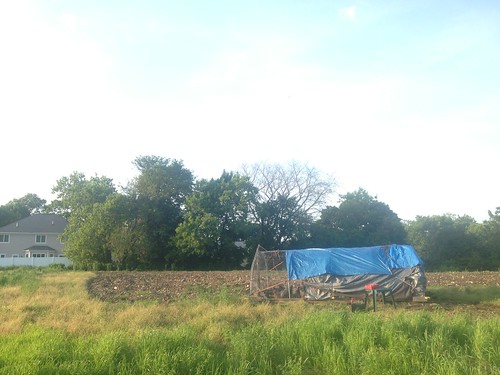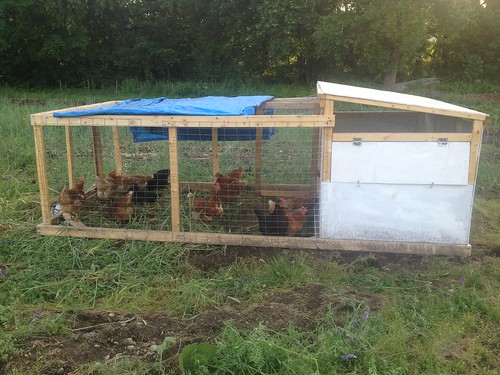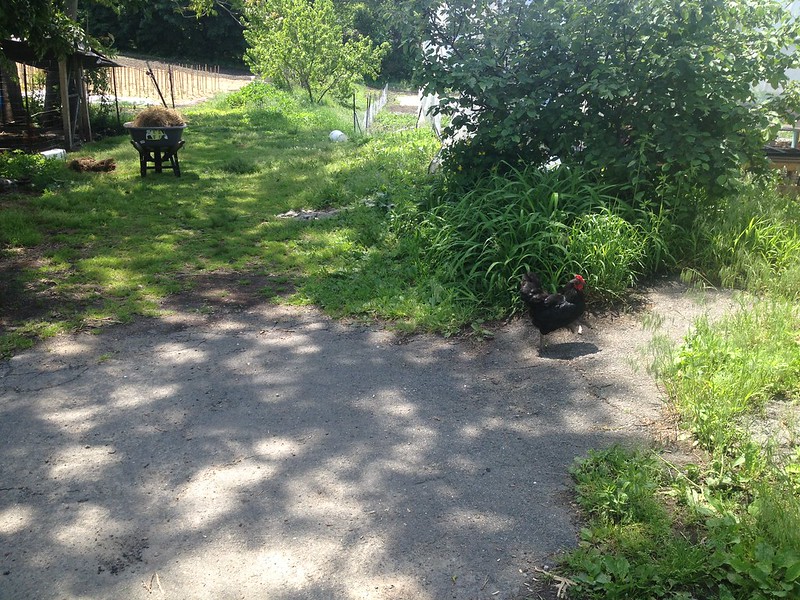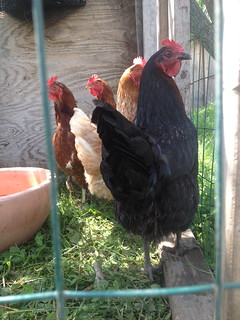Hey all. The season is really in gear, and we’re growing a lot right now, in all senses of the word. Just last thursday we welcomed eight new hens into our hode-podge flock. The new birds are all a year old this month; three of them are Black Stars, and five of them are Red Stars.
I arrived at work a week ago to find the new hens waiting for me in a small pen. I was the only one working at the time, so I began the careful task of shuttling each girl over to her new home in my arms. One thing I noticed was how comparatively cagy the Black Stars were, although having never worked with this breed before I’m wont to generalize from a sample size of three. One of the Black Stars escaped my tender clutches, and boy did she scoot around the farm! It was actually pretty adorable to see a chicken book it like that.

Now the new girls are sitting pretty in a mobile chicken structure we built for them. Our old chicken structure is a very basic frame made of 2×4’s, with bent metal hoops wrapped in chicken wire. We use tarps to provide shelter, and run an electrified wire around the perimeter to discourage digging predators. The new structure is part run, part coop, and can be scooted along the pastures to provide fresh forage for our hens. The coop portion of the structure has a welded metal mesh floor (1″ mesh), which protects them from digging predators (we have coyotes!) without necessitating an electrified barrier. It also allows their poops to pass through, fertilizing the ground below, and minimizing cleanup for us! The run is exactly that: a pen to allow the girls to forage on fresh pasture every day.
The downside of this structure is its weight: it’s very heavy and requires two people or a tractor to move. We chose to construct the run with 2x3s for stability, but they’re quite heavy. In our next iteration, we’ll probably do a hybrid design with a bent metal hoops forming a run, affixed to the solid coop structure.

We’re of course really excited to have these girls on our farm, but their breeds don’t come without some concerns. Both Red and Black stars are what’s known as “hybrid” breeds, although they’re not traditional F1 hybrids. These birds are bred to produce an incredible amount of eggs, nearly one a day throughout the year, but their prolific laying comes at a biological cost. Hybrid hens are “designed” (and they really are designed) to work within an industrial model, as an interchangeable part of an egg-production machine– a part meant to be replaced once a year. As a result, the health of these birds is compromised– these birds are prone to cloacal prolapse, broken bones, and after a year they generally begin to fall apart. Additionally, it seems to me as if these ‘hybrid’ birds are more prone to aggressive neurotic behavior, pecking at each other mercilessly and cannibalizing vulnerable birds. So, as I said, we’re happy to welcome these girls into our farm, but we’re going to be switching to more stable, “heritage” breeds, like our Barred Rocks, in the future. For more information about hybrid chickens, check out this paper.
But I’d prefer not to end this post on a down note like that, so here’s a picture of that escapee in action:



